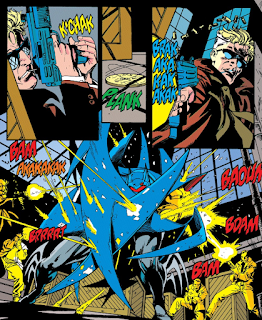by Scott Snyder and Greg Capullo
Batman's adventures continue in his so-called "zeroth" year of existence in Gotham City. This collection includes two storyarcs, the "Dark City" storyline which dovetails into "Savage City." Dark City introduces Dr. Death to the New 52-niverse, a mad scientist responsible for a bone growth serum meant to repair physical trauma. It's titled "Dark City" because of the Riddler's takeover of the electrical grid and subsequent blackout. Savage City sees the fallout from Dark City after a superstorm, in which the Riddler completes his takeover of Gotham City and isolates it from the rest of the world. There's a lot to unpack in the 8 issues, but that's the bare bones of it. Add in some prevalent flashbacks of Bruce Wayne as a child, and Bruce Wayne as a teenager, and there you have "Zero Year -- Dark City."
Batman's adventures continue in his so-called "zeroth" year of existence in Gotham City. This collection includes two storyarcs, the "Dark City" storyline which dovetails into "Savage City." Dark City introduces Dr. Death to the New 52-niverse, a mad scientist responsible for a bone growth serum meant to repair physical trauma. It's titled "Dark City" because of the Riddler's takeover of the electrical grid and subsequent blackout. Savage City sees the fallout from Dark City after a superstorm, in which the Riddler completes his takeover of Gotham City and isolates it from the rest of the world. There's a lot to unpack in the 8 issues, but that's the bare bones of it. Add in some prevalent flashbacks of Bruce Wayne as a child, and Bruce Wayne as a teenager, and there you have "Zero Year -- Dark City."
It's kind of outrageous how far they go in so few issues. The Riddler has an army of drones, a secret base that's jamming communication with the outside world, and even a pit of lions to dump his foes in. I know it's no less absurd than established narratives like Arkham City or No Man's Land but talk about scope creep -- the Riddler's done more in Batman's zeroth year than the Joker did in Volume 3, supposedly year six of the Batman's career! I know I complain that some storyarcs take too many issues to tell, but I think a huge storyline like Savage City would have benefited from more than 4 issues. To me, it was a Planet Hulk style story, and that story took 13 issues to tell.
Both stories are wrapped within the theme of "zero." It's here that you learn that the two featured villains are foils to Batman. There's a long exposition-y action scene where Dr. Death explains what the moon meant to him and his son, who tragically died on an army mission in the desert. Previously he pretended that the moon would watch over them both, but when his son was killed, he adopted a nihilistic view. The moon in the sky is empty, and the thought that it offered protection was an empty promise, giving Dr. Death a tragic origin. In his mind, you have to seize your own means of protecting yourself. This is at odds with what Bruce Wayne as Batman eventually learns over the course of the two stories. He gains allies in both Alfred and Lieutenant Gordon, knowing that he can't do what he wants for Gotham, alone.
What zero means for the Riddler is that, now that he's culled the weak from Gotham City after the superstorm, they all live in a shared year zero from which they can start the future and model a superior existence for the rest of the world, by....answering riddles. It's a little far-fetched, but if you've ever wanted to see the Riddler get his own terrorist city, look no further.
Compare this to what zero means for Bruce Wayne. He was the man who came back to Gotham City, despite all of the things that's happened to it, and happened to him. Through "Secret City" he learned that he couldn't do it in secret. He needed to be both Batman and Bruce Wayne. Through "Dark City" he learned he couldn't do it alone. He needed to work together with his friends and the city's professionals. And through "Savage City" he put them all together. There's such an on-the-nose climax scene when Batman has to turn the power back on to the city, in order to prevent it from being bombed by the Federal Air Force. The Riddler has a battery pack hooked to his chest that signals the city's power grid. Bruce has to literally attach the battery to his chest and pump 1000V into it, bonding his heart with that of the city's, signaling that the city no longer belongs to the Riddler. He's literally given his heart to the city: it's the bat's now.
BONUS highlight: around the climax of Dark City, Batman has to take a leap of faith to make a 70-foot jump to the Riddler's blimp, when his grappling hook fires only up to 50 feet. He jumps, and the winds of the storm do the rest for him in an epic homage to Frank Miller's Dark Knight Returns.
One more Miller homage: this time, explaining Alfred's motivations and his new understanding of the man that Bruce Wayne has become.
















































